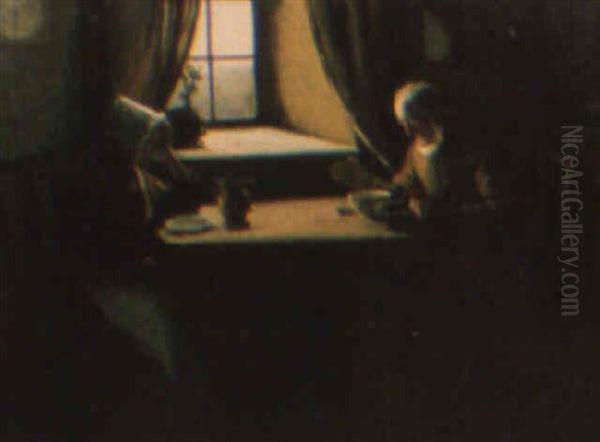
Henry John Dobson, born in 1858 and passing in 1928, stands as a significant figure in Scottish art, particularly renowned for his tender and evocative genre scenes that captured the heart of Scottish domestic life and character during the late Victorian and Edwardian eras. While the initial query presented some geographical and professional misattributions, the Henry John Dobson of art historical importance was unequivocally a Scottish painter, whose work resonated deeply with a public appreciative of narrative, sentiment, and the familiar charms of everyday existence. His paintings, often imbued with a soft, warm light and meticulous detail, offer a window into the social fabric, values, and intimate moments of a bygone Scotland.
Early Life and Artistic Foundations
Born in St John's Town of Dalry, Kirkcudbrightshire, Scotland, Henry John Dobson was immersed in a culture rich with storytelling and strong community bonds, elements that would later permeate his artistic output. His early artistic inclinations led him to pursue formal training at the Royal Institution in Edinburgh, which was the precursor to the Royal Scottish Academy's life school. Here, he would have honed his skills in draughtsmanship and oil painting, likely studying the works of earlier Scottish masters who had already established a tradition of genre painting.
The artistic environment in Scotland during Dobson's formative years was vibrant. The legacy of painters like Sir David Wilkie, who had achieved international fame in the early 19th century with his lively scenes of Scottish rural life, was still palpable. Wilkie's ability to combine keen observation with narrative flair set a high bar for subsequent generations. Dobson would also have been aware of the work of Thomas Faed, another prominent Scottish genre painter whose depictions of Scottish peasant life, often tinged with pathos and sentiment, were immensely popular. These artists, along with others like Erskine Nicol, who also specialized in Scottish and Irish genre scenes, created a fertile ground for an artist interested in depicting the lives of ordinary people.
Thematic Focus: The Heart of Scottish Domesticity

Dobson's oeuvre is characterized by a profound focus on the domestic sphere. He excelled in portraying intimate interior scenes, often centered around family life, childhood, and old age. His canvases frequently feature crofters' cottages, humble kitchens, and cozy parlors, where the daily rituals and quiet dramas of life unfold. These settings are not mere backdrops but are rendered with an attention to detail that speaks to the importance of home and hearth in Scottish culture. Worn furniture, simple crockery, flickering fireplaces, and well-thumbed Bibles often populate his scenes, adding layers of authenticity and emotional resonance.
Children are a recurring motif in Dobson's work, depicted with a sensitivity that captures their innocence, curiosity, and sometimes their vulnerability. Whether shown at play, learning their lessons, or simply observing the adult world around them, his child figures are rarely idealized beyond a gentle sentimentality. Similarly, his portrayals of the elderly are marked by dignity and respect, often highlighting their wisdom, resilience, or the quiet companionship of their later years. The intergenerational bonds within families are a particularly strong theme, underscoring the continuity of tradition and the enduring strength of familial ties.
Artistic Style and Influences
Henry John Dobson's style is firmly rooted in the Victorian tradition of narrative realism. His technique is characterized by careful drawing, smooth brushwork, and a keen eye for detail. He was a master of capturing the textures of fabrics, the play of light on surfaces, and the subtle nuances of human expression. His compositions are typically well-structured, guiding the viewer's eye to the focal point of the narrative. The use of warm, often interior, light – perhaps from a window or a fireplace – creates an atmosphere of intimacy and comfort, though he was equally capable of rendering the cooler, more diffused light of the Scottish landscape when his scenes ventured outdoors.
One can discern the influence of 17th-century Dutch Golden Age painters such as Johannes Vermeer and Pieter de Hooch in Dobson's meticulous rendering of interiors and his sensitive handling of light. Like these Dutch masters, Dobson found beauty and significance in the everyday. However, his narrative impulse and sentimental leanings align him more closely with his British Victorian contemporaries. While perhaps not as overtly dramatic as some, his paintings tell stories that were readily understood and appreciated by his audience.
His approach differed from the more avant-garde movements that were gaining traction during his career, such as Impressionism or the work of the Glasgow Boys – a group of Scottish painters including Sir James Guthrie, E.A. Hornel, and John Lavery, who were exploring new techniques and subject matter influenced by French realism and plein-air painting. Dobson remained committed to a more traditional, academic style that prioritized narrative clarity and emotional engagement.
Representative Works: Capturing a Nation's Soul
Several of Henry John Dobson's paintings have become iconic representations of Scottish life and values. "The Crofter's Grace" is perhaps one of his most famous works. It depicts a humble crofting family gathered around a simple table, heads bowed in prayer before a meal. The scene is imbued with a quiet piety and a sense of gratitude, reflecting the deep religious faith prevalent in many parts of Scotland. The details, from the simple fare to the earnest expressions of the figures, contribute to the painting's powerful emotional impact.
Another well-known piece, "Burns' Grace" (often titled "The Cotter's Saturday Night" in reference to Robert Burns' poem), similarly captures a moment of domestic devotion, linking his work directly to Scotland's rich literary heritage. Such paintings resonated with a sense of national identity and pride. "Auld Lang Syne" is another work that taps into deep-seated Scottish traditions, evoking feelings of nostalgia and camaraderie.
Paintings like "The Intruder," showing a child cautiously approaching a new pet, or "Mitherless Bairn," which poignantly depicts an orphaned child, showcase his ability to evoke pathos without excessive melodrama. "The Peat Sledge" and "The Spinning Wheel" highlight traditional rural occupations and domestic crafts, preserving a visual record of a way of life that was gradually changing with industrialization and modernization. These works, and many others, demonstrate his consistent engagement with themes of family, faith, community, and Scottish heritage.
Exhibitions, Recognition, and Contemporaries
Henry John Dobson was a regular and respected exhibitor at major Scottish art institutions. He frequently showed his work at the Royal Scottish Academy (RSA) in Edinburgh, where he was elected an Associate (ARSA) in 1895 and a full Academician (RSA) in 1918. He also exhibited at the Royal Glasgow Institute of the Fine Arts. His success was not confined to Scotland; he also exhibited at the Royal Academy of Arts (RA) in London, the Walker Art Gallery in Liverpool, and other prominent venues across Britain, indicating a broad appeal for his particular brand of sentimental genre painting.
During his lifetime, Dobson's work was popular with the public and generally well-received by critics who valued skilled craftsmanship and relatable subject matter. He operated in a British art world that, while seeing the stirrings of modernism, still had a large appetite for narrative and anecdotal painting. Artists like Luke Fildes, known for "The Doctor," or Frank Holl, who painted scenes of social concern, shared a commitment to realism and storytelling, albeit often with a more overtly social or dramatic edge. Even the grand classical scenes of Sir Lawrence Alma-Tadema or the romantic medievalism of Lord Frederic Leighton and Sir John Everett Millais (in his later career) were part of this broader Victorian taste for art that was both visually rich and thematically accessible. Dobson carved out his niche by focusing specifically on the Scottish experience, presenting it with an affectionate and often idealized lens.
He was a contemporary of the aforementioned Glasgow Boys, whose bolder brushwork and more objective approach to realism offered a contrast to Dobson's more polished and sentimental style. While their paths diverged stylistically, both contributed to the richness and diversity of Scottish art at the turn of the 20th century. Other notable Scottish painters of the period included William McTaggart, celebrated for his expressive seascapes and depictions of children, whose work, while different in technique, shared a deep connection to Scottish life and landscape.
Later Career and Artistic Progeny
Dobson continued to paint throughout his life, maintaining his characteristic style and thematic concerns. His dedication to his craft and his consistent output ensured his continued presence in the Scottish art scene. His work provided a comforting and familiar vision of Scotland, one that emphasized enduring values and traditions in a period of significant social and technological change.
An interesting aspect of his legacy is his artistic family. Two of his sons, Cowan Dobson (1894-1980) and Henry Raeburn Dobson (1901-1985), also became accomplished painters. Cowan Dobson, in particular, gained renown as a portrait painter, working in a more fluid and fashionable style than his father, and painted many prominent figures of his day. Henry Raeburn Dobson also pursued portraiture and figure painting. The continuation of artistic talent within the Dobson family speaks to a supportive and creative home environment. This familial connection to the arts further solidifies the Dobson name within the annals of Scottish painting.
Legacy and Historical Perspective
Today, Henry John Dobson's paintings are valued not only for their artistic merit but also as important social documents. They offer a glimpse into the domestic interiors, customs, and emotional tenor of late 19th and early 20th-century Scotland. While art historical tastes have evolved, and the overt sentimentality of some Victorian painting fell out of favor for a period, there has been a renewed appreciation for the skill, narrative power, and cultural insights offered by artists like Dobson.
His work provides a counterpoint to the more radical artistic developments of his time. While he may not have been an innovator in the modernist sense, he was a master of his chosen genre, creating images that deeply resonated with his contemporaries and continue to evoke a strong sense of place and time. His paintings are held in numerous public and private collections, and reproductions of his most popular works, like "The Crofter's Grace," have ensured their enduring familiarity.
In the broader context of British art, Dobson can be seen as a regional interpreter of the wider Victorian enthusiasm for genre painting. While artists like George Elgar Hicks captured the bustle of London life, or William Powell Frith depicted contemporary social scenes like "Derby Day," Dobson focused his lens on the more intimate and often rural settings of his native Scotland. His contribution lies in his ability to imbue these scenes with a quiet dignity and a heartfelt emotion that transcended mere illustration.
Conclusion: An Enduring Affection for Scotland
Henry John Dobson RSA dedicated his artistic career to chronicling the life and spirit of Scotland. Through his meticulously rendered and sentiment-filled genre scenes, he captured the essence of Scottish domesticity, piety, and community. His paintings of crofters, families, children, and the elderly, set within the warm confines of humble homes or against the backdrop of the Scottish landscape, spoke to a deep affection for his homeland and its people.
While contemporary with more revolutionary artistic movements, Dobson remained true to a tradition of narrative realism that found a wide and appreciative audience. His works, such as "The Crofter's Grace" and "Burns' Grace," have become cherished images, reflecting enduring Scottish values. As an artist who skillfully combined technical proficiency with genuine emotional engagement, Henry John Dobson holds a secure place in the history of Scottish art, remembered as a painter who lovingly documented the heart and soul of a nation. His legacy is not only in the canvases he left behind but also in the window they provide into the intimate world of Victorian and Edwardian Scotland.